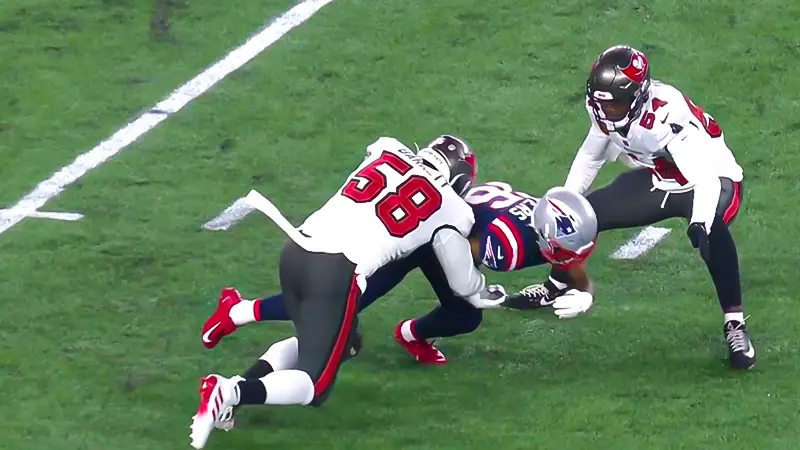In American football, the term “incomplete pass” can shift the momentum of a game in an instant. This happens when a legal forward pass hits the ground before any player gains possession, halting the play and advancing the down by one.
For the offensive team, an incomplete pass means no yardage gained and a stopped game clock, which can be a crucial factor in the game’s strategy.
Imagine a quarterback launching a perfect spiral towards a wide receiver, only for the ball to slip through the receiver’s fingers and hit the turf. This scenario not only frustrates fans but also impacts the team’s drive.
Understanding the dynamics of an incomplete pass, including its implications on the game clock and down progression, is essential for grasping the intricacies of football strategy.
What Are Incomplete Passes? Explained Simply
An incomplete pass in American football can change the game’s dynamics in an instant. It’s essential to grasp the basic rules and consequences tied to incomplete passes.
Definition and Basic Rules
An incomplete pass happens when a forward pass hits the ground before being caught. The play ends immediately upon the ball touching the ground. For a pass to be incomplete, the quarterback must legally throw it forward from behind the line of scrimmage.
Any backward throw falling to the ground is a fumble, not an incomplete pass. An incomplete pass results in no yardage gained for the offensive team, and the game clock stops in most cases.
Consequences of an Incomplete Pass
Incomplete passes significantly affect game strategy by stopping the game clock, allowing the offensive team more planning time, especially in crucial final minutes. They can lead to wasted downs and force punts if the team fails to advance the ball.
Additionally, numerous incomplete passes can harm a quarterback’s confidence. Defensively, capitalizing on incomplete passes can disrupt the opponent’s momentum and regain control.
Understanding these repercussions helps players and coaches strategize effectively, influencing the game’s outcome.
Key Historical Changes in Incomplete Pass Rules
In American football, key historical changes in incomplete pass rules have significantly influenced game dynamics and strategies over the years. These rule changes often stemmed from pivotal moments that prompted the NFL to examine and adjust regulations.
The Tuck Rule: A Noteworthy Example
The tuck rule, introduced in 1999, defined that if a quarterback lost control of the ball while their arm was moving forward to pass, it would be an incomplete pass, not a fumble.
The rule gained immense attention during the 2001 AFC Divisional Playoff game between the New England Patriots and the Oakland Raiders when a fumble by Patriots quarterback Tom Brady was reversed to an incomplete pass under this rule.
The controversy surrounding this decision spurred extensive debate, and the rule was ultimately repealed in 2013.
Impact of Rule Changes on Game Strategy
Rule changes related to incomplete passes have significantly impacted game strategy.
The NFL’s adjustment, which allows only the fumbling player to recover and advance the ball on fourth down or after the two-minute warning, arose from the “Holy Roller” play in 1978 to prevent deliberate advancement of fumbles.
These changes forced teams to rethink their offensive strategies, particularly in crucial moments, leading them to prioritize secure passing plays to minimize turnovers and control the game clock.
Differentiating Incomplete Passes from Fumbles
Recognizing the differences between incomplete passes and fumbles is crucial for players, coaches, and fans. Misunderstanding these rules can lead to confusion during critical game moments.
What Constitutes a Fumble?
A fumble occurs when a player loses possession of the ball after having established control. For example, if a quarterback drops the ball while attempting to throw, it’s considered a fumble rather than an incomplete pass.
The referees determine possession based on whether the player has secured the ball and made a football move, such as taking a step or attempting to evade a tackle.
How Rule Interpretations Affect Turnovers
Rule interpretations directly impact turnovers, shifting game momentum swiftly. Officials must decide whether a quarterback’s arm was moving forward to judge intent in potential incomplete pass situations.
The “tuck rule,” active from 1999 to 2013, showcased this complexity by stating an incomplete pass occurs if a quarterback starts to bring the ball back to the body and loses it.
These interpretations emphasize the need for teams to focus on ball security to prevent costly turnovers, shaping offensive strategies to reduce risks and maintain control.
Pass Interference and Incomplete Passes
Pass interference in American football directly influences the occurrence of incomplete passes, adding a layer of complexity to play outcomes.
Identifying Pass Interference
Pass interference occurs when a player, either offensive or defensive, touches an opponent in a way that hinders their ability to catch the ball. Defensive pass interference results in a penalty, giving the offensive team an automatic first down.
The only exception is if the ball is uncatchable, in which case no pass interference penalty is called. Recognizing pass interference requires referees to make quick, precise judgments, often impacting game momentum significantly.
Impact on the Outcome of a Play
Pass interference penalties can alter the trajectory of a drive, often converting what would be an incomplete pass into a first down and continued offensive opportunity.
If the penalty isn’t called, defenses gain strategic advantages by forcing an incomplete pass, leading to potential clock stoppages and advantageous field positions.
Properly understanding these nuances helps teams strategize effectively, preparing for scenarios where pass interference may become a pivotal game factor.
Intentional Incompletions
Intentional incompletions can be strategic decisions made by quarterbacks to avoid loss of yardage or to manage the clock.
Strategic Use in Games
In critical situations, quarterbacks often throw intentional incompletions to stop the game clock without incurring a loss of yardage. Coaches may also call for such plays to avoid sacks and potential turnovers.
When no receivers are open, a quarterback may quickly throw the ball out of bounds or into the ground. This strategy can preserve field position and maintain the team’s offensive rhythm.
For example, during two-minute drills, intentional incompletions can be crucial to stopping the clock and planning subsequent plays.
Rules Governing Intentional Grounding
Intentional grounding rules aim to prevent quarterbacks from unfairly avoiding sacks. According to the rule, a quarterback must be outside the tackle box and the thrown ball must cross the line of scrimmage to avoid a penalty.
If these conditions aren’t met, referees penalize the offense for intentional grounding, resulting in a loss of down and yardage. This rule ensures that quarterbacks can’t exploit the option of intentional incompletions without consequence.
Understanding these guidelines helps teams make informed strategic decisions while avoiding detrimental penalties.
Frequently Asked Questions
What was the tuck rule and how did it change the game?
The tuck rule, implemented in 1999 and repealed in 2013, stated that any forward arm motion by a quarterback was considered an incomplete pass instead of a fumble, which greatly affected game outcomes and strategies.
What is intentional grounding and its penalties?
Intentional grounding occurs when a quarterback throws the ball to avoid a sack without a receiver in the vicinity. This results in a loss of down and a yardage penalty, making it critical for strategic gameplay.
Why might a quarterback intentionally throw an incomplete pass?
Quarterbacks may intentionally throw incompletions to stop the game clock, avoid negative yardage from a sack, or reset the play without any loss, strategically preserving momentum and time.
Can pass interference be challenged by coaches?
Yes, coaches can challenge pass interference calls. If they believe the ruling on the field is incorrect, they can use a challenge to potentially change the call and impact the game’s results.
Is there a difference between an incomplete pass and a fumble when the quarterback loses the ball?
Yes, if a quarterback loses the ball before starting the forward throwing motion, it’s a fumble. If the ball is released during the forward motion and hits the ground, it’s an incomplete pass.
Conclusion
Incomplete passes play a vital role in shaping the dynamics of American football. They affect game strategy, clock management, and decision-making for both players and coaches.
Historical rule changes and distinctions between incomplete passes and fumbles highlight the complexity of the game. Pass interference can drastically alter play outcomes, while intentional incompletions serve as strategic tools to manage the clock and avoid negative yardage.
Understanding the rules around intentional grounding is essential for teams to make smart choices and avoid penalties. Mastery of these elements allows teams to maintain offensive momentum and execute their game plans effectively.
Moreover, defensive strategies often aim to pressure quarterbacks into making incomplete throws, leveraging blitzes and coverage schemes. Analyzing film of incomplete passes helps teams refine their tactics.








Ashley Hopkinson